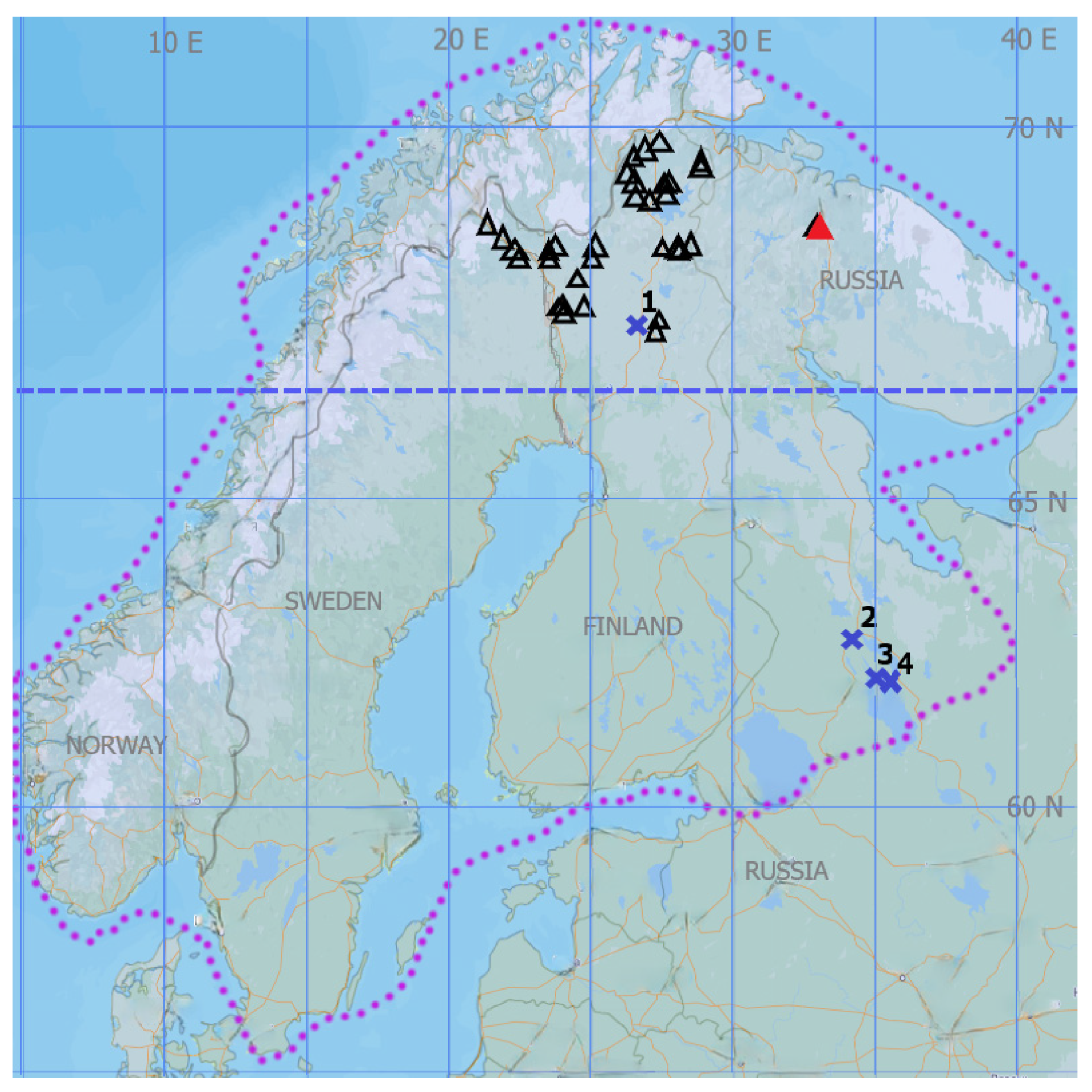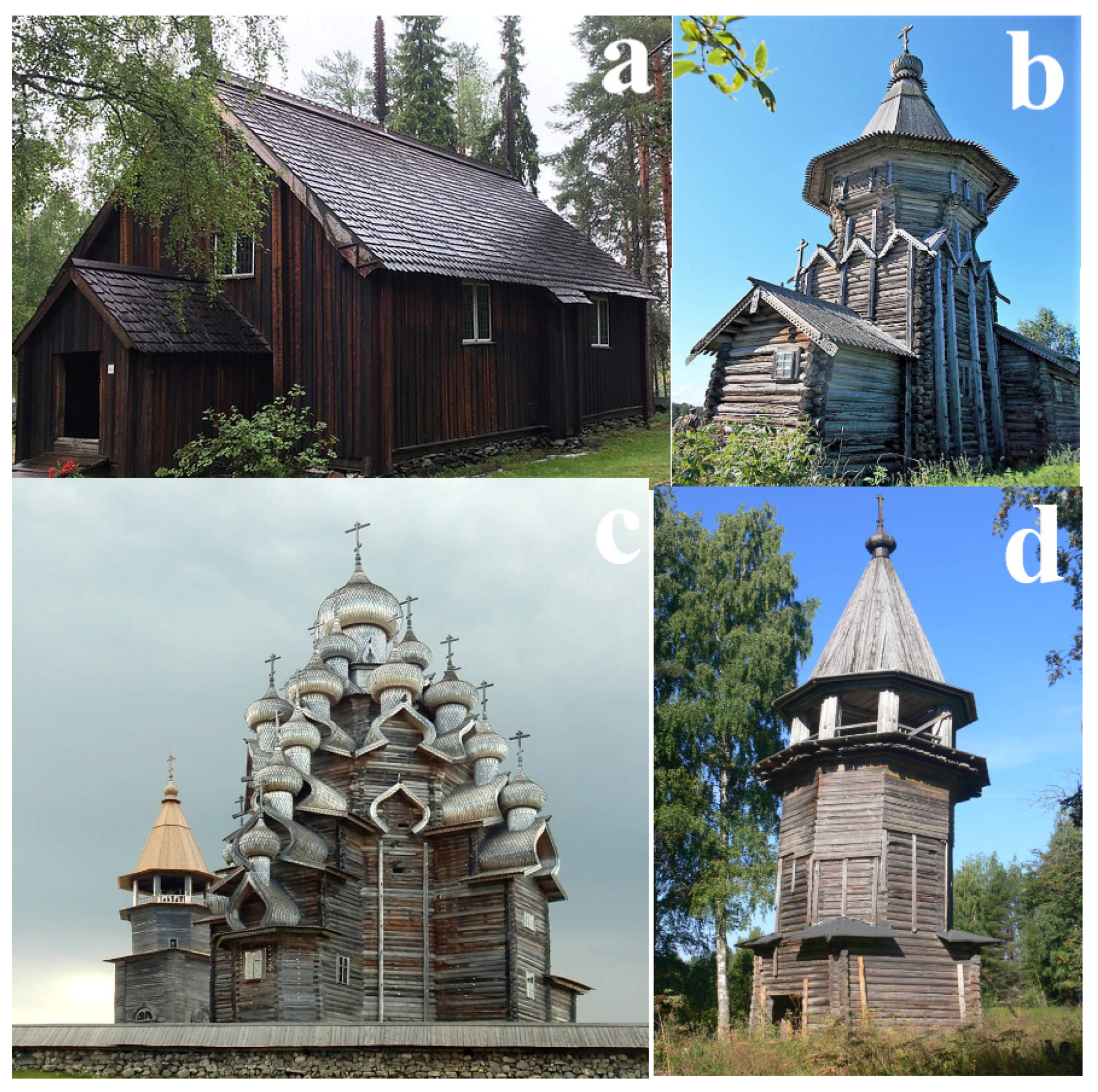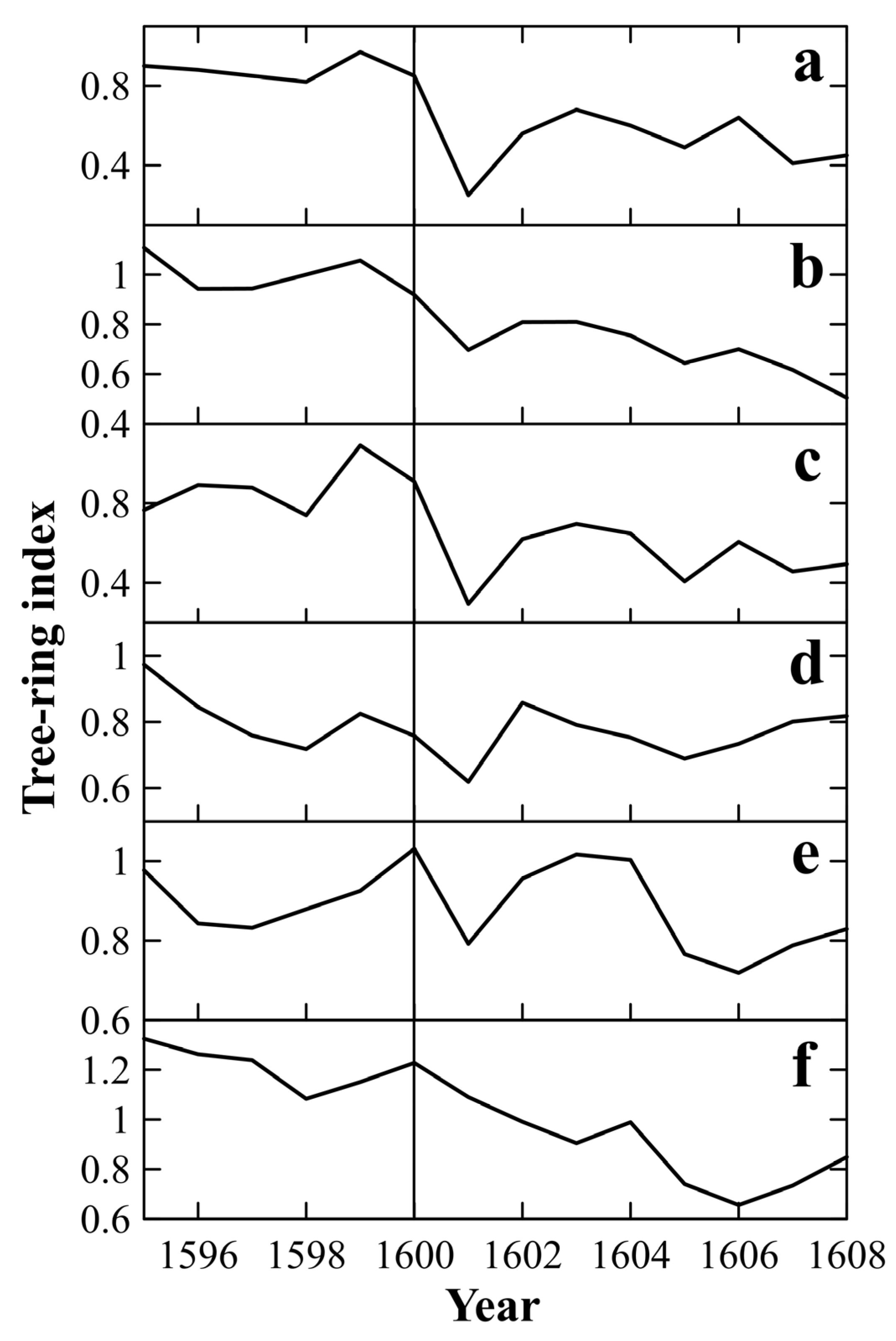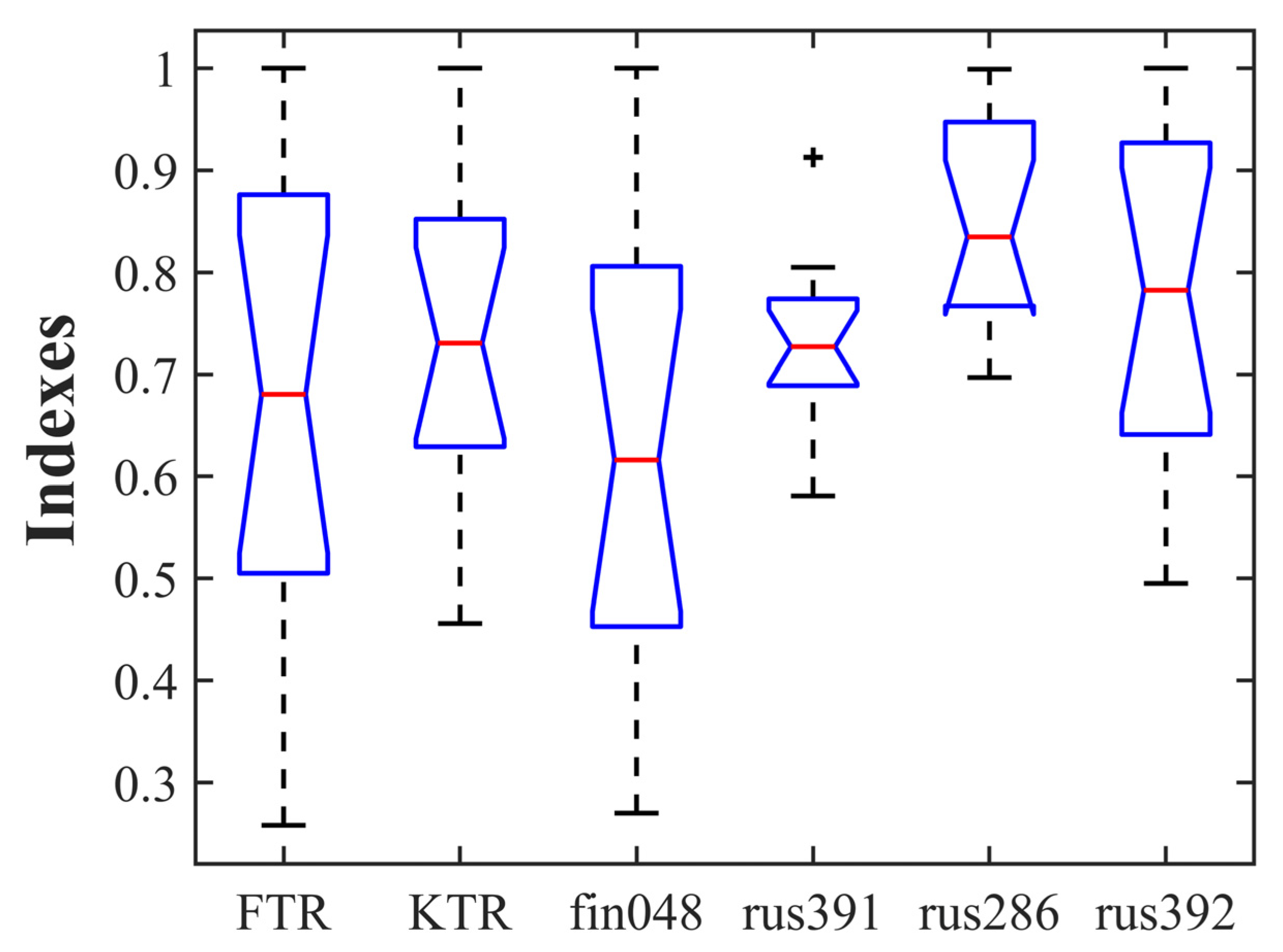Volcanic Impact Patterns in Tree Rings from Historical Wood in Northern Fennoscandia’s Old Churches
Abstract
1. Introduction
2. Materials and Methods
2.1. Study Site
2.1.1. Kola Peninsula
2.1.2. Northern Finnish Lapland
2.1.3. Northern Karelia, the Lake Onega Region
2.2. Data Sets and Methodology
2.2.1. Regional Chronologies from Living and Subfossil Trees
2.2.2. Historical Tree-Ring Data
2.3. Statistical Analysis
3. Results
4. Discussion
5. Conclusions
Author Contributions
Funding
Data Availability Statement
Conflicts of Interest
References
- Schweingruber, F.H. Tree Rings. Basics and Applications of Dendrochronology, 2nd ed.; Kluwer Academic Publishers: Dordrecht, The Netherlands, 1988. [Google Scholar] [CrossRef]
- Nash, S.E. Archaeological tree-ring dating at the millennium. J. Archaeol. Res. 2002, 10, 243–275. [Google Scholar] [CrossRef]
- Edvardsson, J.; Almevik, G.; Lindblad, L.; Linderson, H.; Melin, K.-M. How cultural heritage studies based on dendrochronology can be improved through two-way communication. Forests 2021, 12, 1047. [Google Scholar] [CrossRef]
- Haneca, K.; Čufar, K.; Beeckman, H. Oaks, tree-rings and wooden cultural heritage: A rewiev of the main characteristics and applications of oak dendrochronology in Europe. J. Archaeol. Sci. 2009, 36, 1–11. [Google Scholar] [CrossRef]
- Sass-Klaassen, U.; Vernimmen, T.; Baittinger, C. Dendrochronological dating and provenancing of timber used as foundation piles under historic buildings in The Netherlands. Int. J. Biodeterior. Biodegrad. 2008, 61, 96–105. [Google Scholar] [CrossRef]
- Bridge, M. Locating the origins of wood resources: A review of dendroprovenancing. J. Archaeol. Sci. 2012, 39, 2828–2834. [Google Scholar] [CrossRef]
- Shumilov, O.I.; Kasatkina, E.A.; Krapiec, M.; Chochorowski, J.; Szychowska-Krapiec, E. Tree-ring dating of Russian Pomor settlements in Svalbard. Dendrochronologia 2020, 62, 125721. [Google Scholar] [CrossRef]
- Gullbrandsson, R.; Hallgren, M.; Linderson, H.; Melin, K.M. Church roofs in a frontier region: Historic timber structures in western Sweden reflect changing influences and resources. In Building Networks: Exchange of Knowledge, Ideas and Materials in Medieval and Post-Medieval Europe. Themes in Contemporary Archaeology; Bouwmeester, J., Patrick, L., Berryman, D., Eds.; Springer: Cham, Switzerland, 2024; pp. 25–37. [Google Scholar] [CrossRef]
- Hansen, G. Domestic and exotic materials in early medieval Norwegian towns: An archaeological perspective on production, procurement and consumption. In Viking-Age Transformations: Trade, Craft, and Resources in Western Scandinavia, 1st ed.; Glørstad, Z.T., Loftsgarden, K., Eds.; Routledge: London, UK; New York, NY, USA, 2017; pp. 59–94. [Google Scholar] [CrossRef]
- Tegel, W.; Vanmoerkerke, J.; Büntgen, U. Updating historical tree-ring records for climate reconstructions. Quat. Sci. Rev. 2010, 29, 1957–1959. [Google Scholar] [CrossRef]
- Läänelaid, A.; Helama, S.; Kull, A.; Timonen, M.; Jaagus, J. Common growth signal and spatial synchrony of the chronologies of tree-rings from pines in the Baltic Sea region over the last nine centuries. Dendrochronologia 2012, 30, 147–155. [Google Scholar] [CrossRef]
- Cooper, R.J.; Melvin, T.M.; Tyers, I.; Wilson, R.J.S.; Briffa, K.R. A tree-ring reconstruction of East Anglian (UK) hydroclimate variability over the last millennium. Clim. Dyn. 2013, 40, 1019–1039. [Google Scholar] [CrossRef]
- Büntgen, U.; Wacker, L.; Nicolussi, K.; Sigl, M.; Güttler, D.; Tegel, W.; Krusic, P.J.; Esper, J. Extraterrestrial confirmation of tree-ring dating. Nature Clim. Change 2014, 4, 404–405. [Google Scholar] [CrossRef]
- Seftigen, K.; Goosse, H.; Klein, F.; Chen, D. Hydroclimate variability in Scandinavia over the last millennium—Insights from a climate model-proxy data comparison. Clim. Past 2017, 13, 1831–1835. [Google Scholar] [CrossRef]
- Helama, S.; Huntamaa, H.; Verkasalo, E.; Läänelaid, A. Something old, something new, something borrowed: New insights to human-environment interaction in medieval Novgorod inferred from tree rings. J. Archaeol. Sci. Rep. 2017, 13, 341–350. [Google Scholar] [CrossRef]
- Helama, S.; Sohar, K.; Läänelaid, A.; Bijak, S.; Jaagus, J. Reconstruction of precipitation variability in Estonia since the 18th century, inferred from oak and spruce tree rings. Clim. Dyn. 2018, 50, 4083–4101. [Google Scholar] [CrossRef]
- Helama, S.; Bartholin, T.S. Åland churches as archives of tree-ring records sensitive to fluctuating climate. Acta Palaeobot. 2019, 59, 131–143. [Google Scholar] [CrossRef]
- Helama, S.; Ratilainen, T.; Ruohonen, J.; Taavitsainen, J.-P. Developing millennial tree-ring chronology for Turku (Åbo) and comparing palaeoclimatic signals inferred from archaeological, subfossil and living Pinus sylvestris data in Southwest Finland. Stud. Quat. 2024, 41, 1–11. [Google Scholar] [CrossRef]
- Balanzategui, D.; Knorr, A.; Heussner, K.-U.; Wazny, T.; Beck, W.; Słowiński, M.; Helle, G.; Buras, A.; Wilmking, M.; Van Der Maaten, A.; et al. An 810-yearhistory of cold season temperature variability for northern Poland. Boreas 2018, 47, 443–453. [Google Scholar] [CrossRef]
- Nechita, C.; Eggertsson, O.; Badea, O.N.; Popa, I. A 781-year oak tree-ring chronology for the Middle Ages archaeological dating in Maramureş (Eastern Europe). Dendrochronologia 2018, 52, 105–112. [Google Scholar] [CrossRef]
- Pearson, C.; Salzer, M.; Wacker, L.; Brewer, P.; Sookdeo, A.; Kuniholm, P. Securing timelines in the ancient Mediterranean using multiproxy annual tree-ring data. Proc. Natl. Acad. Sci. USA 2020, 117, 8410–8415. [Google Scholar] [CrossRef]
- Seim, A.; Linscott, K.; Heussner, K.-U.; Bonde, N.; Battinger, C.; Stornes, J.M.; Bartholin, T.S.; Linderholm, H.W. Diverse construction types and local timber sources characterize early medieval church roofs in southwestern Sweden. Dendrchronologia 2015, 35, 39–50. [Google Scholar] [CrossRef]
- Szilágyi, K.; Sand-Eriksen, A. Medieval Norwegian wooden (stave) churches: Built heritage and places of memory. Hung. Archaeol. 2021, 10, 30–40. [Google Scholar] [CrossRef]
- Savolainen, P.; Seppänen, L.; Laine, L.; Huttunen, M.; Aakala, T. Revealing the innovations in Late Medieval roof structures of Finland. Int. J. Wood Cult. 2023, 3, 64–85. [Google Scholar] [CrossRef]
- Khodakovsky, E.; Lexau, S.S. Historic Wooden Architecture in Europe and Russia: Evidence, Study and Restoration; Birkhäuser: Basel, Switzerland, 2015. [Google Scholar] [CrossRef]
- Khodakovsky, E. Wooden Church Architecture of the Russian North: Regional Schools and Traditions (14th–19th Centuries); Routledge: London, UK; New York, NY, USA, 2016. [Google Scholar] [CrossRef]
- Narodny Katalog Pravoslavnoi Arkhitektury [National Catalog of Orthodox Architecture]. Available online: https://sobory.ru/wood (accessed on 15 October 2024).
- Baillie, M.G.L. Marking in marker dates: Towards an archaeology with historical precision. World Archaeol. 1991, 23, 432–438. [Google Scholar] [CrossRef]
- Bleicher, N. Four levels of patterns in tree-rings: An archaeological approach to dendroecology. Veget. Hist. Archaeobot. 2014, 23, 615–627. [Google Scholar] [CrossRef]
- Pearson, C.; Sigl, M.; Burke, A.; Davies, S.; Kurbatov, A.; Severi, M.; Cole-Dai, J.; Innes, H.; Albert, P.G.; Helmick, M. Geochemical ice-core constraints on the timing and climatic impact of Aniakchak II (1628 BCE) and Thera (Minoan) volcanic eruptions. PNAS Nexus 2022, 1, 1–12. [Google Scholar] [CrossRef]
- Helama, S.; Mielikäinen, M.; Timonen, M.; Eronen, M. Finnish supra-long tree-ring chronology extended to 5634 BC. Nor. J. Geogr. 2008, 62, 271–277. [Google Scholar] [CrossRef]
- Shumilov, O.I.; Kasatkina, E.A.; Mielikainen, K.; Timonen, M.; Kanatjev, A.G. Palaeovolcanos, solar activity and pine tree-rings from the Kola Peninsula (northwestern Russia) over the last 560 years. Int. J. Environ. Res. 2011, 5, 855–864. [Google Scholar] [CrossRef]
- Kasatkina, E.A.; Shumilov, O.I.; Timonen, M.; Kanatjev, A.G. Consequences of powerful volcanic eruptions according to the dendrochronological data. Izv. Atmos. Ocean. Phys. 2013, 49, 432–438. [Google Scholar] [CrossRef]
- Kasatkina, E.A.; Shumilov, O.I.; Timonen, M.; Kanatjev, A.G. Impact of powerful volcanic eruptions and solar activity on the climate above the Arctic Circle. Geofis. Int. 2018, 57, 67–77. [Google Scholar] [CrossRef]
- Helama, S.; Holopainen, J.; Macias-Fauria, M.; Timonen, M.; Mielikäinen, K. A chronology of climatic downturns through the mid- and late-Holocene: Tracing the distant effects of explosive eruptions from palaeoclimatic and historical evidence in northern Europe. Polar Res. 2013, 32, 15866. [Google Scholar] [CrossRef]
- De Silva, S.L.; Zielinski, G.A. Global influence of the AD 1600 eruption of Huaynaputina, Peru. Nature 1998, 393, 455–458. [Google Scholar] [CrossRef]
- Scuderi, L.A. Tree-ring evidence for climatically effective volcanic eruptions. Quarter. Res. 1990, 34, 67–85. [Google Scholar] [CrossRef]
- Hammer, C.U.; Clausen, H.B.; Dansgaard, W. Greenland ice sheet evidence of postglacial volcanism and its climatic impact. Nature 1980, 288, 230–235. [Google Scholar] [CrossRef]
- Verosub, K.L.; Lippman, J. Global impacts of the 1600 eruption of Peru’s Huaynaputina. EOS Trans. 2008, 89, 141–142. [Google Scholar] [CrossRef]
- Fei, J.; Zhang, D.D.; Lee, H.F. 1600 AD Huaynaputina eruption (Peru), abrupt cooling, and epidemics in China and Korea. Adv. Meteorol. 2015, 2016, 3217038. [Google Scholar] [CrossRef]
- Stoffel, M.; Khodri, M.; Corona, C.; Guillet, S.; Poulain, V.; Bekki, S.; Guiot, J.; Luckman, B.H.; Oppenheimer, C.; Lebas, N.; et al. Estimates of volcanic-induced cooling in the Northern Hemisphere over the past 1,500 years. Nat. Geosci. 2015, 8, 784–788. [Google Scholar] [CrossRef]
- Borisenkov, Y.P. Documentary evidence from the U.S.S.R. In Climate Since A.D. 1500; Bradley, R.S., Jones, P., Eds.; Routledge: London, UK, 1995; pp. 171–183. [Google Scholar] [CrossRef]
- Robock, A. Volcanic eruptions and climate. Rev. Geophys. 2000, 38, 191–219. [Google Scholar] [CrossRef]
- Toohey, M.; Krüger, K.; Schmidt, H.; Timmreck, C.; Sigl, M.; Stoffel, M.; Wilson, R. Disproportionately strong climate forcing from extratropical explosive volcanic eruptions. Nat. Geosci. 2019, 12, 100–107. [Google Scholar] [CrossRef]
- Ogle, N.; Turney, C.S.M.; Kalin, R.M.; O’Donnel, L.; Butler, C.J. Palaeovolcanic forcing of short-term dendroisotopic depletion: The effect of decreased solar intensity on Irish oak. Geophys. Res. Lett. 2005, 32, L04708. [Google Scholar] [CrossRef]
- Donner, J. The Fennoscandian shield within Fennoscandia. Bull. Geol. Soc. Finland 1996, 68, 99–103. [Google Scholar] [CrossRef]
- International Tree Ring Data Bank. Available online: http://www.ncdc.noaa.gov/data-access/paleoclimatology-data/datasets/tree-ring (accessed on 12 November 2024).
- Kolchin, B.A.; Chernykh, N.B. Dendrochronology of Eastern Europe; Nauka: Moscow, Russia, 1977. (In Russian) [Google Scholar]
- Chernykh, N.B. Dendrochronology of the architectural monuments in Karelia. Kratk. Soobshcheniya Instituta Arkheologii–KSIA [Brief Commun. Inst. Archeol.] 2001, 211, 113–120. (In Russian) [Google Scholar]
- Äyräs, M.; Kashulina, G. Regional patterns of element content in the organic horizon of podzols in the central part of the Barents region (Finland, Norway and Russia) with special reference to heavy metals (Co, Cr, Cu, Fe, Ni, Pb, V and Zn) and sulphur as indicators of airborne pollution. J. Geochem. Explor. 2000, 68, 127–144. [Google Scholar] [CrossRef]
- Saltan, N.V.; Sviatkovskaya, E.A. Ecophysiological features of Larix sibirica in urbanecosystems of the Kola north in the railway influence zone. Czech Polar Rep. 2021, 11, 305–307. [Google Scholar] [CrossRef]
- Blinova, I.; Chmielewski, F.-M. Climatic warming above the Arctic Circle: Are there trends in timing and length of the thermal growing season in Murmansk Region (Russia) between 1951 and 2012? Int. J. Biometeorol. 2015, 59, 693–705. [Google Scholar] [CrossRef] [PubMed]
- Gervais, B.R.; MacDonald, G.M.; Snyder, J.A.; Kremenetski, C.V. Pinus sylvestris treeline development and movement on the Kola Peninsula of Russia: Pollen and stomate evidence. J. Ecol. 2002, 90, 627–638. [Google Scholar] [CrossRef]
- Lindholm, T.; Heikkilä, R. Finland: Land of Mires; Finnish Environment Institute: Helsinki, Finland, 2006. [Google Scholar]
- Kivinen, S.; Rasmus, S.; Jylhä, K.; Laapas, M. Long-Term climate trends and extreme events in northern Fennoscandia (1914–2013). Climate 2017, 5, 16. [Google Scholar] [CrossRef]
- Autere, O. Arctic Light Phenomena as an Attraction in Finnish Lapland. Ph.D. Thesis, Lapland University of Applied Sciences, Rovaniemi, Finland, 2014. [Google Scholar]
- Krikunova, A.I.; Savelieva, L.A.; Long, T.; Leipe, C.; Kobe, F.; Kostromina, N.A.; Vasilyeva, A.V.; Tarasov, P.E. Postglacial vegetation and climatechange in the Lake Onega region of eastern Fennoscandia derived from a radiocarbon-dated pollen record. Quatern. Int. 2024, 695, 31–44. [Google Scholar] [CrossRef]
- Antipin, V.; Heikkilä, R.; Lindholm, T.; Tokarev, P. Vegetation of Lishkmokh mire in Vodlozersky National Park, eastern Karelian republic, Russia. Suo 1997, 48, 93–114. [Google Scholar]
- Kanatjev, A.G.; Shumilov, O.I.; Kasatkina, E.A. Software for dendrochronological measurements. Instrum. Exp. Tech. 2014, 57, 214–217. [Google Scholar] [CrossRef]
- Holmes, R.L. Computer-Assisted Quality Control in Tree-Ring Dating and Measurement. Tree-Ring Bull. 1983, 43, 69–75. Available online: http://hdl.handle.net/10150/261223 (accessed on 13 February 2025).
- Cook, E.R.; Kairiukstis, L.A. Method of Dendrochronology; Kluwer Academic Publishing: Dordrecht, Germany, 1997. [Google Scholar]
- Kairamo, M. The restoration of Sodankylä Old Church 1992–1995. In Wood Structures: A Global Forum on the Treatment, Conservation, and Repair of Cultural Heritage; Kelley, S.J., Loferski, J.R., Salenikovich, A.J., Stern, E.G., Eds.; ASTM International: West Conshohocken, PA, USA, 2000; Volume 1351, pp. 131–152. [Google Scholar] [CrossRef]
- Corder, G.W.; Foreman, D.I. Nonparametric Statistics for Non-Statisticians: A Step-by-Step Approach, 2nd ed.; John Wiley & Sons: Hoboken, NJ, USA, 2014. [Google Scholar] [CrossRef]
- IPCC. Summary for Policymakers. In Climate Change 2023: Synthesis Report. Contribution of Working Groups I, II and III to the Sixth Assessment Report of the Inergovernmental Panel on Climate Change; Core Writing Team, Lee, H., Romero, J., Eds.; IPCC: Geneva, Switzerland, 2023; pp. 1–34. [Google Scholar] [CrossRef]
- Bokhorst, S.; Phoenix, G.K.; Berg, M.P.; Callagan, T.V.; Kirby-Lambert, C.; Bjerke, J.W. Climatic and biotic extreme events moderate long-term responses of above- and belowground sub-Arctic heathland communities to climate change. Glob. Chang. Biol. 2015, 21, 4063–4075. [Google Scholar] [CrossRef]
- Tenkanen, A.; Keinänen, M.; Oksanen, E.; Keski-Saari, S.; Kontunen-Soppela, S. Polar day syndrome: Differences in growth, photosynthesis traits and sink-size patterns between northern and southern Finnish silver birch (Betula pendula Roth) provenances in native and non-native photoperiods. Tree Physiol. 2023, 43, 16–30. [Google Scholar] [CrossRef] [PubMed]
- Shumilov, O.I.; Kasatkina, E.A.; Potorochin, E.O. Solar and climatic factors affecting tree-ring growth of mountain birch (Betula pubescens) beyond the northern timberline on Kola Peninsula, Northwestern Russia. Forests 2024, 15, 37. [Google Scholar] [CrossRef]
- Esper, J.; Schneider, L.; Krusic, P.J.; Luterbacher, J.; Büntgen, U.; Timonen, M.; Sirocko, F.; Zorita, E. European summer temperature response to annually dated volcanic eruptions over the past nine centuries. Bull. Volcanol. 2013, 75, 736. [Google Scholar] [CrossRef]
- Sadler, J.P.; Grattan, J.P. Volcanoes as agents of past environmental change. Glob. Planet. Chang. 1999, 21, 181–186. [Google Scholar] [CrossRef]
- D’Arrigo, R.; Wilson, R.; Anchukaitis, K.J. Volcanic cooling signal in tree ring temperature records for the past millennium. J. Geophys. Res. 2013, 118, 9000–9010. [Google Scholar] [CrossRef]
- Guevara-Murua, A.; Williams, C.A.; Hendy, E.J.; Rust, A.C.; Cashman, K.V. Observations of a stratospheric aerosol veil from a tropical volcanic eruption in December 1808: Is this the Unknown~1809 eruption? Clim. Past 2014, 10, 181–186. [Google Scholar] [CrossRef]





| # | No * | Object | Place | Coord. | Years AD ** | d *** | Originator/Source |
|---|---|---|---|---|---|---|---|
| 1 | finl048 | Sodankylä Old Church | Sodankylä, Finland | (67.4° N, 26.6° E) | 1484–1688 | 67 p < 0.001 | Originator: Meriläinen, J.; Lindholm, M.; Timonen, M./[47] |
| 2 | russ391 | Church of Peter and Paul | Lychny Island, Karelia, Russia | (62.5° N, 34° E) | 1432–1617 | 24 p < 0.01 | Originator: Kolchin, B.A.; Chernykh, N.B.; Karpukhin, A.A.; Matskovsky, V.V.; Solovyeva, L.N./[47,48] |
| 3 | russ286 | Church of the Transfiguration, Kizhi Pogost | Kizhi Island, Karelia, Russia | (62.1° N, 35.2° E) | 1405–1713 | 14 p < 0.05 | Originator: Kolchin, B.A.; Chernych, N.B.; Karpukhin, A.A./[47] |
| 4 | russ392 | Church of Elijah the Prophet and the Three Saints | Lukostrov Island, Karelia, Russia | (62° N, 35.7° E) | 1549–1669 | 11 p < 0.05 | Originator: Chernykh, N.B.; Sargeeva, N.F.; Karpukhin, A.A.; Matskovsky, V.V.; Solovyeva, L.N./[47,49] |
Disclaimer/Publisher’s Note: The statements, opinions and data contained in all publications are solely those of the individual author(s) and contributor(s) and not of MDPI and/or the editor(s). MDPI and/or the editor(s) disclaim responsibility for any injury to people or property resulting from any ideas, methods, instructions or products referred to in the content. |
© 2025 by the authors. Licensee MDPI, Basel, Switzerland. This article is an open access article distributed under the terms and conditions of the Creative Commons Attribution (CC BY) license (https://creativecommons.org/licenses/by/4.0/).
Share and Cite
Shumilov, O.I.; Kasatkina, E.A.; Timonen, M.; Potorochin, E.O. Volcanic Impact Patterns in Tree Rings from Historical Wood in Northern Fennoscandia’s Old Churches. Forests 2025, 16, 573. https://doi.org/10.3390/f16040573
Shumilov OI, Kasatkina EA, Timonen M, Potorochin EO. Volcanic Impact Patterns in Tree Rings from Historical Wood in Northern Fennoscandia’s Old Churches. Forests. 2025; 16(4):573. https://doi.org/10.3390/f16040573
Chicago/Turabian StyleShumilov, Oleg I., Elena A. Kasatkina, Mauri Timonen, and Evgeniy O. Potorochin. 2025. "Volcanic Impact Patterns in Tree Rings from Historical Wood in Northern Fennoscandia’s Old Churches" Forests 16, no. 4: 573. https://doi.org/10.3390/f16040573
APA StyleShumilov, O. I., Kasatkina, E. A., Timonen, M., & Potorochin, E. O. (2025). Volcanic Impact Patterns in Tree Rings from Historical Wood in Northern Fennoscandia’s Old Churches. Forests, 16(4), 573. https://doi.org/10.3390/f16040573






